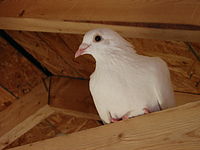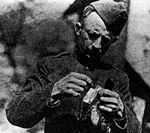- Homing pigeon
-
The homing pigeon is a variety of domestic pigeon derived from the Rock Pigeon (Columba livia domestica) selectively bred to find its way home over extremely long distances.[1] The wild rock pigeon has an innate homing ability,[2] meaning that it will generally return to its own nest and its own mate. This made it relatively easy to breed from the birds that repeatedly found their way home over long distances. Flights as long as 1,800 km (1,100 mi) have been recorded by birds in competition pigeon racing.[3] Their average flying speed over moderate distances (500 miles) is around 80 km/h (50 mph),[citation needed] but speeds of up to 177 km/h (110 mph) have been observed in top racers for short distance (100 miles).[4]
Homing pigeons are referred to as carrier pigeons when they are used to carry messages.
Contents
History
The Egyptians and the Persians first used carrier pigeons 3,000 years ago[citation needed]. They also were used to proclaim the winner of the Olympics.[5] Messenger pigeons were used as early as 1150 in Baghdad[6] and also later by Genghis Khan. In Damietta, by the mouth of the Nile, the Spanish traveller Pedro Tafur saw carrier pigeons for the first time, in 1436, though he imagined that the birds made round trips, out and back.[7] The Republic of Genoa equipped their system of watch towers in the Mediterranean Sea with pigeon posts. Tipu Sultan used carrier pigeons. They returned to the Jamia Masjid mosque in Srirangapatna, which was his headquarters. The pigeon holes may be seen in the mosque's minarets to this day. In 1860, Paul Reuter, who later founded Reuters press agency, used a fleet of over 45 pigeons to deliver news and stock prices between Brussels and Aachen, the terminals of early telegraph lines. The outcome of the Battle of Waterloo was also first delivered by a pigeon to England. During the Franco-Prussian War pigeons were used to carry mail between besieged Paris and the French unoccupied territory. Possibly the first regular air mail service in the world was Mr. Howie's Pigeon-Post service from the Auckland New Zealand suburb of Newton to Great Barrier Island, starting in 1896. Certainly the world’s first 'airmail' stamps were issued for the Great Barrier Pigeon-Gram Service from 1898 to 1908.[8] Homing pigeons were still employed in the 21st century by certain remote police departments in Orissa state in eastern India to provide emergency communication services following natural disasters. In March 2002, it was announced that India's Police Pigeon Service messenger system in Orissa was to be retired, due to the expanded use of the Internet.[9] The Taliban banned the keeping and/or use of homing pigeons in Afghanistan.[10]
Research has been performed with the intention of discovering how pigeons, after being transported, can find their way back from distant places they have never visited before. Most researchers believe that homing ability is based on a "map and compass" model, with the compass feature allowing birds to orient and the map feature allowing birds to determine their location relative to a goal site (home loft).[11] While the compass mechanism appears to rely on the sun, the map mechanism has been highly debated.[12] Some researchers believe that the map mechanism relies on the ability of birds to detect the Earth's magnetic field. It is true that birds can detect a magnetic field, to help them find their way home. A light-mediated mechanism that involves the eyes and is lateralized has been examined somewhat, but recent developments have implicated the trigeminal nerve in magnetoception.[13][14] Research by Floriano Papi (Italy, early 1970s) and more recent work, largely by Hans Wallraff, suggests that instead pigeons orient themselves using the spatial distribution of atmospheric odors,[12] known as olfactory navigation. Near their home lofts, in areas they have previously visited, pigeons probably are guided by visual landmarks.
Various experiments suggest that different breeds of homing pigeons rely on different cues to different extents. Charles Walcott at Cornell was able to demonstrate that while pigeons from one loft were confused by a magnetic anomaly in the Earth it had no effect on birds from another loft a mile away. Other experiments have shown that altering the perceived time of day with artificial lighting or using air conditioning to eliminate odors in the pigeons' home roost affected the pigeons' ability to return home.
Some research also indicates that homing pigeons navigate by following roads and other man-made features, making 90 degree turns and following habitual routes, much the same way that humans navigate.[15]
Roles
As carrier pigeons
When used as carrier pigeons in pigeon post a message is written on thin light paper and rolled into a small tube attached to the bird's leg. Pigeons can only go back to one "mentally marked" point that they have identified as their home. So "pigeon mail" can only work when the sender is actually holding the receiver's pigeons. White homing pigeons are used in Release Dove ceremonies at weddings, funerals, and some sporting events.
In war
Birds were used extensively during World War I. One homing pigeon, Cher Ami, was awarded the French Croix de guerre for his heroic service in delivering 12 important messages, despite having been very badly injured.
During World War II, the Irish Paddy, the American G.I. Joe and the English Mary of Exeter all received the Dickin Medal. They were among 32 pigeons to receive this award, for their gallantry and bravery in saving human lives with their actions. Eighty-two homing pigeons were dropped into Holland with the First Airborne Division Signals as part of Operation Market Garden in World War II. The pigeons' loft was located in London which would have required them to fly 240 miles to deliver their messages.[16] Also in World War II, hundreds of homing pigeons with the Confidential Pigeon Service were airdropped into northwest Europe to serve as intelligence vectors for local resistance agents. Birds played a vital part in the Invasion of Normandy as radios could not be used for fear of vital information being intercepted by the enemy.
In computing
The humorous IP over Avian Carriers (RFC 1149) is an Internet protocol for the transmission of messages via homing pigeon. Originally intended as an April Fools' Day RFC entry, this protocol was implemented and used, once, to transmit a message in Bergen, Norway on April 28, 2001.[17]
In September 2009, a South African IT company, based in Durban, pitted an 11-month-old bird armed with a data packed 4GB memory stick against the ADSL service from the country's biggest internet service provider, Telkom. The pigeon named Winston took an hour and eight minutes to carry the data 80 km (50 mi). Including downloading, it took two hours, six minutes, and 57 seconds for the data to arrive, the same amount of time it took to transfer 4% of the data over the ADSL[18][19]
See also
- List of pigeon breeds
- American Show Racer
- Domestic pigeon
- Dovecote
- Olfactory navigation
- Pigeon intelligence
- Pigeon post
- Pigeon photography
- Tippler
- War pigeon
- Otto J. Zahn, who established a pigeon messenger service from Santa Catalina Island to the mainland of California
References
- ^ Levi, Wendell (1977 Pg82). The Pigeon. Sumter, S.C.: Levi Publishing Co, Inc. ISBN 0853900132.
- ^ Blechman, Andrew (2007). Pigeons-The fascinating saga of the world's most revered and reviled bird.. St Lucia, Queensland: University of Queensland Press. ISBN 9780702236419. http://andrewblechman.com/learn_more.html.
- ^ Walcott, Charles. "Pigeon Homing: Observations, Experiments and Confusions" (Pdf article). Journal of Experimental Biology. http://jeb.biologists.org/cgi/reprint/199/1/21.pdf. Retrieved 2008-01-04.
- ^ "The Speed of Birds" (Web article). BBC.Co.UK. http://www.bbc.co.uk/nature/animals/birds/weeklyfeature/speedofbirds/. Retrieved 2008-01-04.
- ^ Blechman, Andrew (2007). Pigeons-The fascinating saga of the world's most revered and reviled bird.. St Lucia, Queensland: University of Queensland Press. ISBN 9780702236419. http://www.uqp.uq.edu.au/book_details.php?isbn=9780702236419.
- ^ First Birds' Inn: About the Sport of Racing Pigeons
- ^ "I saw there for the first time carrier pigeons, which take letters in their tail-feathers. They carry them from the place where they are bred to other places, and when the letters are detached they are set free and return to their homes. By this means the inhabitants have speedy news of all who come and go by sea or land." {Pedro Tafur, Andanças e viajes).
- ^ The Great Barrier Island Pigeon-Gram Service
- ^ "Indian pigeons lose out to e-mail". BBC News. 2002-03-26. http://news.bbc.co.uk/1/hi/world/south_asia/1892085.stm. Retrieved 2010-03-27.
- ^ "Some of the restrictions imposed by Taliban on women in Afghanistan" (Web article). Revolutionary Association of the Women of Afghanistan (RAWA). http://www.rawa.org/rules.htm. Retrieved 2008-01-03.
- ^ Bingman, V. P. (1998). Spatial representations and homing pigeon navigation. In S. Healy (Ed). Spatial representation in animals. (pp. 67-85). Oxford: Oxford University Press.
- ^ a b Wallraff, H.G. (2004). Avian olfactory navigation: its empirical foundation and conceptual state. Animal Behaviour, 67, 189-204.
- ^ Mora, C. V., Davison, M., Wild, J. M., and Walker, M. M. (2004). Magnetoreception and its trigeminal mediation in the homing pigeon. Nature, 432, 508-511.
- ^ Gagliardo, A., Ioale, P., Savini, M., and Wild, J. M. (2006). Having the nerve to home: trigeminal magnetoreceptor versus olfactory mediation of homing in pigeons. The Journal of Experimental Biology, 209, 2888-2892.
- ^ "Pigeons reveal map reading secret". BBC News (5 Feb, 2004). 2004-02-05. http://news.bbc.co.uk/2/hi/uk_news/3460977.stm. Retrieved 2008-07-02.
- ^ Cornelius Ryan - A Bridge Too Far
- ^ Bergen Linux User Group - The highly unofficial CPIP WG
- ^ Govender, Peroshni (2009-09-09). "Pigeon transfers data faster than South Africa's Telkom". Reuters (September 9, 2009). http://www.reuters.com/article/oddlyEnoughNews/idUSTRE5885PM20090909. Retrieved 2009-10-09.
- ^ "SA pigeon 'faster than broadband'". BBC (September 10, 2009). 2009-09-10. http://news.bbc.co.uk/1/hi/world/africa/8248056.stm. Retrieved 2009-10-09.
Books
- Chico, The story of a Homing Pigeon in the Great War Lucy M Blanchard, Diggory Press, ISBN 978-1846850394
- Wringer by Jerry Spinelli.
The definitive publication listed below as it appeared in "The Thoroughbred"
External links
- An informative magazine article written in the 1880s
- Pigeon and Business and Communication
- The three most important things that every pigeon fancier should know
- [1] (Newspaper article on the '97 pigeon race "disaster")
- The System of Military Dovecotes in Europe from an 1891 Scientific American article at Project Gutenberg
- RFC 1149 - A Standard for the Transmission of IP Datagrams on Avian Carriers
- http://www.pigeon.org/beginnerscorner.htm - Great site for beginners.
- Resource for pigeon racers
- pigeons Holland
- Popular Science, November 1941, Round Trip War Birds article on US Army Signal Corps use of homing pigeons with first high speed photos showing how a pigeon flies
- Barnhart & Son Lofts -- Long time Breeder, Exhibitor and Judge of Fancy and Racing Pigeons
Categories:- Pigeon racing
- Animals in sport
- Domestic pigeons
- Domesticated pigeon breeds
- Early telecommunications
Wikimedia Foundation. 2010.




